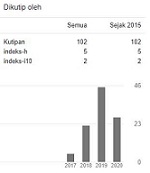TEACHING SPEAKING USING FISHBOWL DISCUSSION STRATEGY AT THE SEVENTH GRADE OF SMP NEGERI I GALIS
Abstract
Many factors can cause the students speaking namely the student interesting in teaching english strategy. As we have known that many strategies can be applied in teaching speaking including fishbowl discussion strategy and the research findings say that fishbowl discussion strategy is effective and creative to use in teaching sepaking. Because of that, the researcher want to observe teaching speaking using fishbowl discussion strategy at the seventh grade of SMP Negeri I Galis Pamekasan. The objective of the study are to describe how teacher applies fishbowl discussion strategy in teaching speaking at the seventh grade students of SMPN 1 Galis Pamekasan. To find out the student’s respond on teaching speaking using fishbowl discussion strategy at the seventh grade of SMPN 1 Galis Pamekasan. In research design of this study used descriptive qualitative research. The object is students of the seventh Grade of SMP Negeri I Galis Pamekasan. The researcher conduct this research two times. The instruments used to got the data were: observation, interview and documentation. Observation was applied in order to know the teacher applies fishbowl discussion strategy in teaching speaking at the seventh grade of SMP Negeri I Galis Pamekasan and the activity in the class. Interview were conducted to know the teacher’s difficulties in teaching speaking English and the students respond on teaching speaking using fishbowl discussion strategy at the sevnth grade of SMP Negeri I Galis Pamekasan. The result showed that teaching speaking using fishbowl discussion strategy at the seventh grade of SMP Negeri I Galis Pamekasan gave the positive responses because teaching speaking using fishbowl discussion strategycould gave the students motivation to speak freely and simply. It also made the students became more active, interested, enjoyable and fun in the class.
Keywords
References
Brown, D. H.1994.Teaching byPrinciples:An interactive approach to language pedagogy. Englewood.
Brown, D. H. 2001. Teaching by principles: An interactive approach to language pedagogy, second edition. San fransisco state university: Longman.
Brown, D. H. 2000. Principles of language learning and teaching, fourth edition. San fransisco state university: Longman.
Burns, A. & Joyce, H. 1997. Focus on Speaking. Sydney: Macquarie University.
Creswell, J. W. 1998. Qualitative Inquiry and Research Design choosing among five tradition. Thousand Oaks: California.
Creswell, J. W. 2012. Educational Research Planning, Conducting, and Evaluating Quantitative and Qualitative Research. Fourth edition. United State of America: PERSON
Taylor, D. Bruce. 2007. Journal of Midle Scholl, access on 13 November 2013
Harmer, Jeremy. 2001. The Practice of English Language Teaching. England Pearson Education Limited.
Harmer, Jeremy. 2001. How To Teach English. Pearson Education Limited.
Hornby, A. S. 2003. Oxford Advanced Learners’ Dictionary, six edition. New York : Oxford University Press.
Hornby, A. S. 1984. Oxford Advanced Learners’ Dictionary of Current English. Walton Street: Oxford University Press.
Kayi, Hayriye. 2006. Teaching Speaking: Activities to Promote Speaking in a Second Language. University of Nevada. The Internet TESL Journal, Vol. XII, No. 11, November 2006 (http://iteslj.org/ being accessed on May 20th, 2009)
Marczyk, Geoffrey, et.al. 2005. Essentials of Research Design and Methodology. John Wiley & Sons, Inc: Canada
Nunan, D. (2003). Practical English Language Teaching. Boston: McGraw Hill.
Sterling, Shirley., Tohe, Laura.(2010). Workshop 3: Research and Discovery, Teaching Strategies, Fishbowl. Retrieved June 04,2010.
DOI: 10.53712/ellite.v1i1.524
Refbacks
- There are currently no refbacks.







